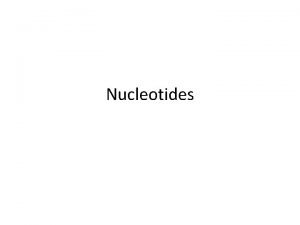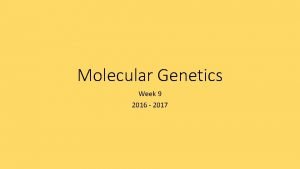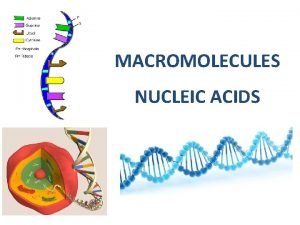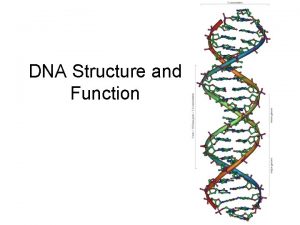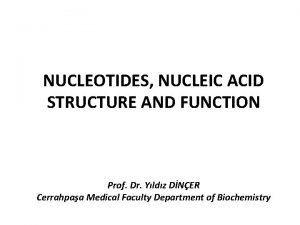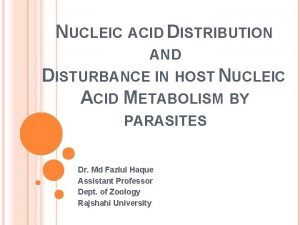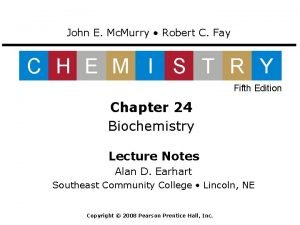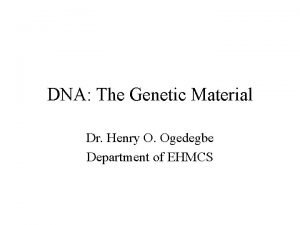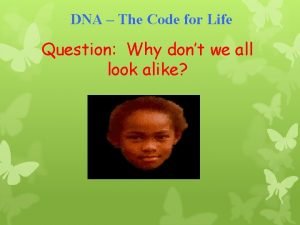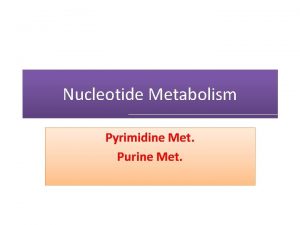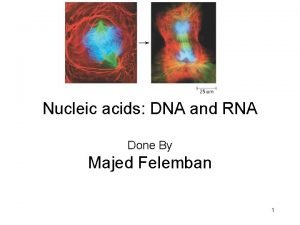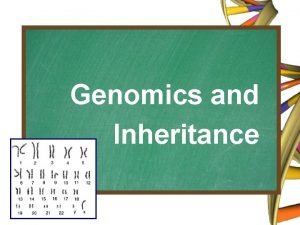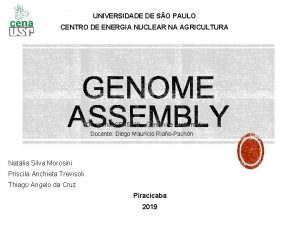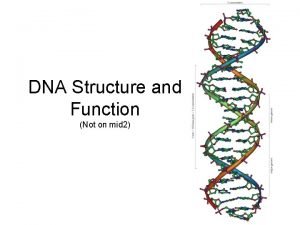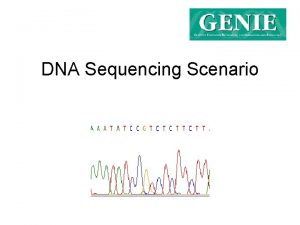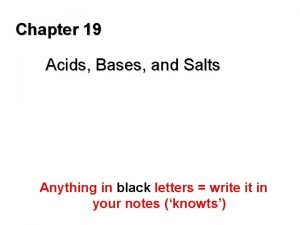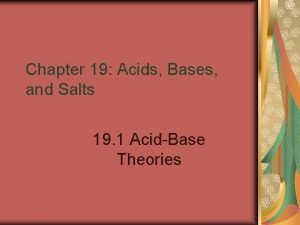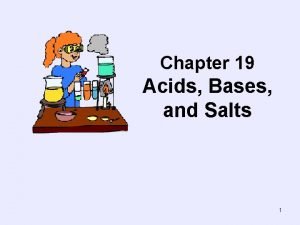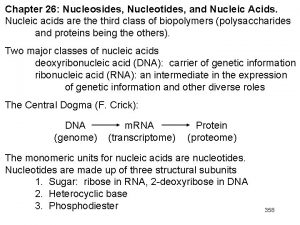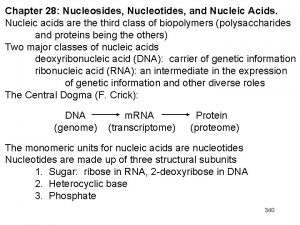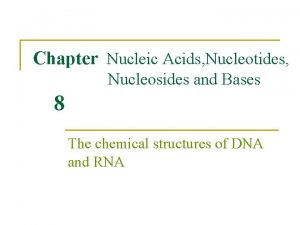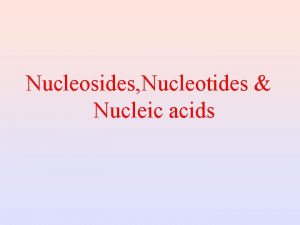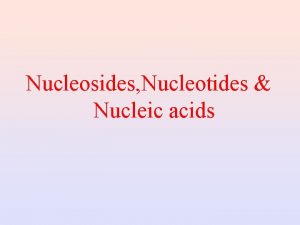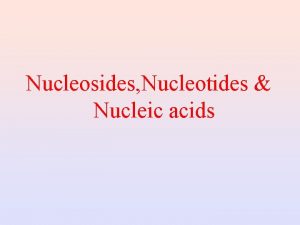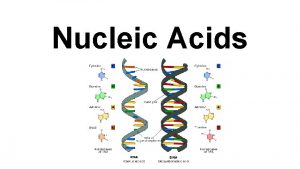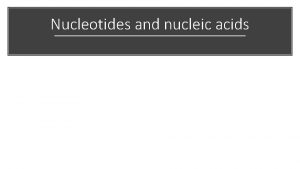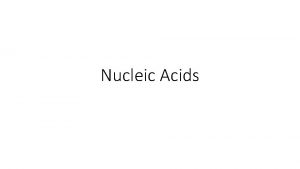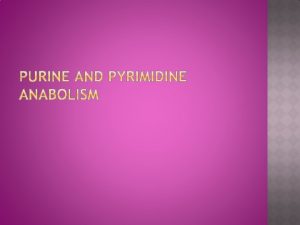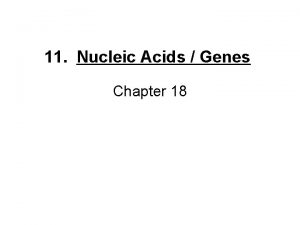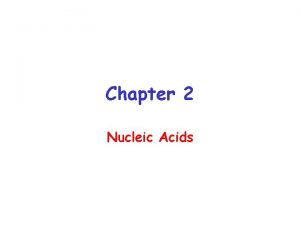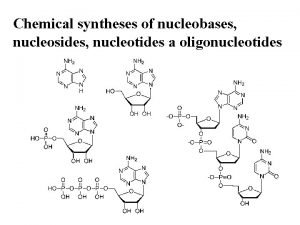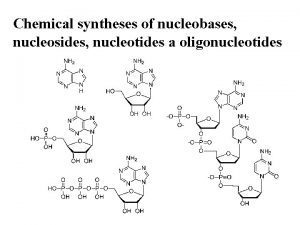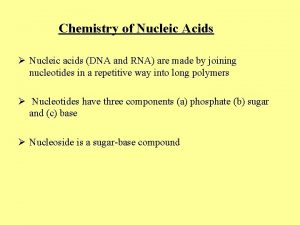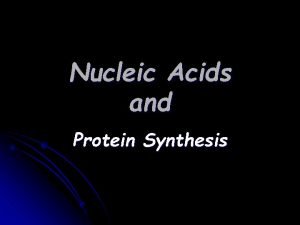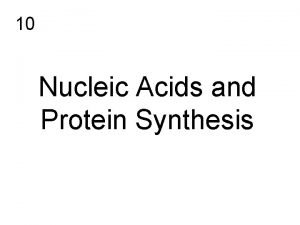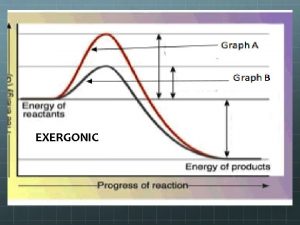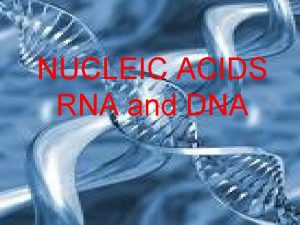Chapter 28 Nucleosides Nucleotides and Nucleic Acids Nucleic


























- Slides: 26

Chapter 28: Nucleosides, Nucleotides, and Nucleic Acids. Nucleic acids are third class of biopolymers (polysaccharides and proteins being the others) Two major classes of nucleic acids deoxyribonucleic acid (DNA): carrier of genetic information ribonucleic acid (RNA): an intermediate in the expression of genetic information and other diverse roles The Central Dogma (F. Crick): DNA (genome) m. RNA (transcriptome) Protein (proteome) The monomeric units for nucleic acids are nucleotides Nucleotides are made up of three structural subunits 1. Sugar: ribose in RNA, 2 -deoxyribose in DNA 2. Heterocyclic base 3. Phosphate 340

Nucleoside, nucleotides and nucleic acids nucleoside nucleotides nucleic acids The chemical linkage between monomer units in nucleic acids 341 is a phosphodiester

28. 1: Pyrimidines and Purines. The heterocyclic base; there are five common bases for nucleic acids (Table 28. 1, p. 1166). Note that G, T and U exist in the keto form (and not the enol form found in phenols) 28. 2: Nucleosides. N-Glycosides of a purine or pyrimidine heterocyclic base and a carbohydrate. The C-N bond involves the anomeric carbon of the carbohydrate. The carbohydrates for nucleic acids are D-ribose and 2 -deoxy-D-ribose 342

Nucleosides = carbohydrate + base (Table 28. 2, p. 1168) ribonucleosides or 2’-deoxyribonucleosides To differentiate the atoms of the carbohydrate from the base, the position number of the carbohydrate is followed by a ´ (prime). The stereochemistry of the glycosidic bond found in nucleic acids 343 is .

28. 3: Nucleotides. Phosphoric acid esters of nucleosides. Nucleotides = nucleoside + phosphate Kinase: enzymes that catalyze the phosphoryl transfer reaction from ATP to an acceptor substrate. M 2+ dependent 344

1971 Nobel Prize in Medicine or Physiology: Earl Sutherland 28. 4: Bioenergetics. (Please read) 28. 5: ATP and Bioenergetics. (Please read) 345

28. 6: Phosphodiesters, Oligonucleotides, and Polynucleotides. The chemical linkage between nucleotide units in nucleic acids is a phosphodiester, which connects the 5’-hydroxyl group of one nucleotide to the 3’-hydroxyl group of the next nucleotide. By convention, nucleic acid sequences are written from left to right, from the 5’-end to the 3’-end. Nucleic acids are negatively charged RNA, X= OH DNA, X=H 28. 7: Nucleic Acids. 1944: Avery, Mac. Leod & Mc. Carty - Strong evidence that DNA is genetic material 1950: Chargaff - careful analysis of DNA from a wide variety of organisms. Content of A, T, C & G varied widely according to the organism, however: A=T and C=G (Chargaff’ Rule) 1953: Watson & Crick - structure of DNA (1962 Nobel Prize 346 with M. Wilkens, 1962)

28. 8: Secondary Structure of DNA: The Double Helix. Initial “like-with-like”, parallel helix: Does not fit with Chargaff’s Rule: A = T G = C Wrong tautomers !! Watson, J. D. The Double Helix, 1968 347

Two polynucleotide strands, running in opposite directions (anti-parallel) and coiled around each other in a double helix. The strands are held together by complementary hydrogenbonding between specific pairs of bases. 348

DNA double helix major groove 12 Å one helical turn 34 Å minor groove 6Å backbone: deoxyribose and phosphodiester linkage bases 349

28. 9: Tertiary Structure of DNA: Supercoils. Each cell contains about two meters of DNA is “packaged” by coiling around a core of proteins known as histones. The DNA-histone assembly is called a nucleosome. Histones are rich is lysine and arginine residues. 350 Pdb code 1 kx 5

“It has not escaped our attention that the specific pairing we have postulated immediately suggests a possible copying mechanism for the genetic material. ” Watson & Crick 28. 10: Replication of DNA. The Central Dogma (F. Crick): DNA transcription m. RNA translation Protein (genome) (transcriptome) (proteome) replication Expression and transfer of genetic information: Replication: process by which DNA is copied with very high fidelity. Transcription: process by which the DNA genetic code is read and transferred to messenger RNA (m. RNA). This is an intermediate step in protein expression Translation: The process by which the genetic code is converted to a protein, the end product of gene expression. The DNA sequence codes for the m. RNA sequence, which codes for the protein sequence 351

DNA is replicated by the coordinated efforts of a number of proteins and enzymes. For replication, DNA must be unknotted, uncoiled and the double helix unwound. Topoisomerase: Enzyme that unknots and uncoils DNA Helicase: Protein that unwinds the DNA double helix. DNA polymerase: Enzyme that replicates DNA using each strand as a template for the newly synthesized strand. DNA ligase: enzyme that catalyzes the formation of the phosphodiester bond between pieces of DNA replication is semi-conservative: Each new strand of DNA contains one parental (old, template) strand one daughter (newly synthesized) strand 352

Unwinding of DNA by helicases expose the DNA bases (replication fork) so that replication can take place. Helicase hydrolyzes ATP in order to break the hydrogen bonds between DNA strands DNA replication 353

DNA Polymerase: the new strand is replicated from the 5’ 3’ (start from the 3’-end of the template) DNA polymerases are Mg 2+ ion dependent The deoxynucleotide 5’-triphosphate (d. NTP) is the reagent for nucleotide incorporation d. NTP 3’-hydroxyl group of the growing DNA strand acts as a nucleophile and attacks the -phosphorus atom of the d. NTP. 354

Replication of the leading strand occurs continuously in the 5’ 3’ direction of the new strand. Replication of the lagging strand occurs discontinuously. Short DNA fragments are initially synthesized and then ligated together. DNA ligase catalyzes the formation of the phosphodiester bond between pieces of DNA. animations of DNA processing: http: //www. wehi. edu. au/education/wehi-tv/dna/ 355

DNA replication occurs with very high fidelity: Most DNA polymerases have high intrinsic fidelity Many DNA polymerases have “proof-reading” (exonuclease) activity Mismatch repair proteins seek out and repair base-pair mismatches due to unfaithful replication 28. 11 Ribonucleic Acid RNA contains ribose rather than 2 -deoxyribose and uracil rather than thymine. RNA usually exist as a single strand. There are three major kinds of RNA messenger RNA (m. RNA): ribosomal RNA (r. RNA) transfer RNA (t. RNA) DNA is found in the cell nucleus and mitochondria; RNA is more 356 disperse in the cell.

Transcription: only one of the DNA strands is copied (coding or antisense strand). An RNA polymerase replicates the DNA sequence into a complementary sequence of m. RNA (template or sense strand). m. RNAs are transported from the nucleus to the cytoplasm, where they acts as the template for protein biosynthesis (translation). A three base segment of m. RNA (codon) codes for an amino acid. The reading frame of the codons is defined by the start and stop codons. 357

The m. RNA is positioned in the ribosome through complementary pairing of the 5’-untranslated region of m. RNA with a r. RNA. Transfer RNA (t. RNA): t-RNAs carries an amino acid on the 3’-terminal hydroxyl (A) (aminoacyl t-RNA) and the ribosome catalyzes amide bond formation. Ribosome: large assembly of proteins and r. RNAs that catalyzes protein and peptide biosynthesis using specific, complementary, anti-parallel pairing interactions between m. RNA and the anti-codon loop of specific t. RNA’s. 358

Although single-stranded, there are complementary sequences within t. RNA that give it a defined conformation. The three base codon sequence of m. RNA are complementary to the “anti-codon” loops of the appropriate t. RNA. The basepairing between the m. RNA and the t. RNA positions the t. RNAs for amino acid transfer to the growing peptide chain. variable loop T C loop D loop aminoacyl t-RNA 359

28. 12: Protein Biosynthesis. Ribosomal protein synthesis P site E site A site 360

28. 13: AIDS. (please read) 28. 14: DNA Sequencing. Maxam-Gilbert: relys on reagents that react with a specific DNA base that can subsequent give rise to a sequence specific cleavage of DNA Sanger: Enzymatic replication of the DNA fragment to be sequenced with a DNA polymerase, Mg+2, and dideoxynucleotides triphosphate (dd. NTP) that truncates DNA replication Restriction endonucleases: Bacterial enzymes that cleave DNA at specific sequences 5’-d(G-A-A-T-T-C)-3’ 3’-d(C-T-T-A-A-G)-5’ Eco. R I 5’-d(G-G-A-T-C-C)-3’ 3’-d(C-C-T-A-G-G)-5’ BAM HI 361

Sanger Sequencing: key reagent: dideoxynucleotides triphosphates (dd. NTP) When a dd. NTP is incorporated elongation of the primer is terminated The dd. NTP is specifically incorporated opposite its complementary nucleotide base 362

Sanger Sequencing Larger fragments Smaller fragments 363

28. 15: The Human Genome Project. (please read) 28. 16: DNA Profiling and Polymerase Chain Reaction (PCR). method for amplifying DNA using a DNA polymerase, d. NTPs and cycling the temperature. Heat stable DNA Polymerases (from archaea): Taq: thermophilic bacteria (hot springs)- no proof reading Pfu: geothermic vent bacteria- proof reading Mg 2+ two Primer DNA strands (synthetic, large excess) one sense primer and one antisense primer one Template DNA strand (double strand) d. NTP’s 1 x 2 = 2 x 2 = 4 x 2 = 8 x 2 = 16 x 2 = 32 x 2 = 64 x 2 = 128 x 2 = 256 x 2 = 512 x 2 = 1, 024 x 2 = 2, 048 x 2 = 4, 096 x 2 = 8, 192 x 2 = 16, 384 x 2 = 32, 768 x 2 = 65, 536 x 2 = 131, 072 x 2 = 262, 144 x 2 = 524, 288 x 2 = 1, 048, 576 In principle, over one million copies per original, can be obtained after just twenty cycles KARY B. MULLIS, 1993 Nobel Prize in Chemistry for his invention of the polymerase chain reaction (PCR) method. 364

Polymerase Chain Reaction For a PCR animation go to: http: //www. blc. arizona. edu/INTERACTIVE/recombinant 3. dna/pcr. html http: //users. ugent. be/~avierstr/principles/pcrani. html 365
 Building blocks for nucleic acids
Building blocks for nucleic acids Hystonia
Hystonia What is an anticodon
What is an anticodon The building block of nucleic acids.
The building block of nucleic acids. Polymer structure of nucleic acids
Polymer structure of nucleic acids Function of nucleic acid
Function of nucleic acid What is nucleic acid made of
What is nucleic acid made of Nucleic acids
Nucleic acids Functions of nucleic acids
Functions of nucleic acids Deoxyribose nucleotide
Deoxyribose nucleotide Nucleic acid
Nucleic acid Foods rich in nucleic acids
Foods rich in nucleic acids Nucleic acids
Nucleic acids Purpose of nucleic acid
Purpose of nucleic acid When dna untwists, unzips, and nucleotides fill in.
When dna untwists, unzips, and nucleotides fill in. Purine nucleotide
Purine nucleotide Amino acid nucleotide
Amino acid nucleotide Four nucleotides of dna
Four nucleotides of dna Order of nucleotides in dna
Order of nucleotides in dna Nucleotides wiki
Nucleotides wiki Functions of nucleotides
Functions of nucleotides Ddntp et dntp
Ddntp et dntp Secret code
Secret code Chapter 14 review acids and bases
Chapter 14 review acids and bases Chapter 19 acids and bases worksheet answers
Chapter 19 acids and bases worksheet answers Chapter 19 acids bases and salts
Chapter 19 acids bases and salts Base water
Base water
